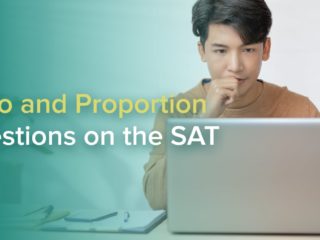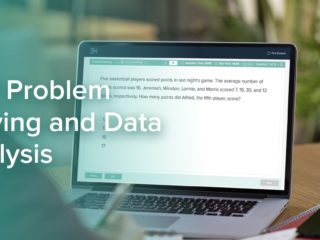| Getting your Trinity Audio player ready... |
If you’re preparing for the digital SAT, it’s essential to understand the SAT Reading and Writing section, as it makes up half of your total score and tests a wide range of reading and grammar skills.
What is the SAT Reading and Writing Section? The SAT Reading and Writing section on the digital SAT replaces the old paper-based Reading and Writing and Language sections. It features 2 adaptive 32-minute modules with 27 multiple-choice questions each, all based on short passages (25–150 words). Unlike the old SAT, each passage is paired with just 1 question. This section tests 4 core skill areas: Craft and Structure, Information and Ideas, Standard English Conventions, and Expression of Ideas. Together, these questions assess reading comprehension, grammar, syntax, vocabulary, and writing effectiveness.
Keep reading to explore how this section compares to the old SAT, what question types you’ll encounter, and how adaptive scoring works.
Here are the topics we’ll cover:
- What Is the Reading and Writing Section of the Digital SAT?
- What Is Included in the Reading and Writing Section of the Digital SAT?
- Digital SAT Reading and Writing: Key Takeaways
- Frequently Asked Questions (FAQ)
- What’s Next?
Let’s start by reviewing the nuts and bolts of what the Reading and Writing section is.
What Is the Reading and Writing Section of the Digital SAT?
On the paper SAT, there was a Reading section and a Writing and Language section. The Reading section featured passages and SAT reading comprehension questions. The Writing and Language section featured passages and questions focused on grammar, syntax, and writing skills. Together, these 2 sections made up the Evidence-Based Reading and Writing (EBRW). Your EBRW score was one-half of your composite SAT score, with Math the other half.
On the digital SAT, the single Reading and Writing section has replaced the 2 EBRW sections. It contains question types from both sections. So, there is no stand-alone digital SAT writing section or digital SAT reading section.
The Reading and Writing section contains 2 modules (as does the SAT Math section). However, both modules are “Reading and Writing” and contain the same question types. So, there are not separate digital SAT reading questions and digital SAT writing questions. Furthermore, instead of receiving a combined EBRW score, you get a single “Reading and Writing” score, which is one-half of your composite SAT score. (Math is the other half.)
Note that all of the types of SAT reading questions and writing questions are multiple-choice with 4 answer choices and 1 correct answer.
KEY FACT:
The digital SAT features a single Reading and Writing section instead of the paper SAT’s separate Reading section and Writing and Language section.
Although the Reading and Writing section basically combines the 2 EBRW sections, it is not exactly like EBRW. So, let’s discuss the key differences between the digital SAT’s Reading and Writing section and EBRW on the paper SAT.
Paper vs. Digital SAT Reading and Writing: Key Differences
The first key difference between Reading and Writing on the old, paper test and the digital SAT is that the modules are shorter and contain fewer questions on the digital version.
On the paper test, there was a 65-minute, 52-question Reading section and a 35-minute, 44-question Writing and Language section. So, there were 96 EBRW questions in total.
On the digital SAT, there are two 32-minute Reading and Writing modules that each contain 27 questions. So, there are 54 Reading and Writing questions in total.
In total, the digital SAT has roughly half the number of Reading and Writing questions as the paper SAT did.
There are a few other key changes to explore about the Reading and Writing section, including:
- shorter passages
- fewer questions per passage
- fewer and different SAT reading and writing question types
- adaptive sections
Let’s discuss each of these new features individually. (For a complete breakdown of all the differences between the old and new SATs, check out our paper vs. digital SAT guide.)
KEY FACT:
The digital SAT Reading and Writing section has two 32-minute, 27-question modules.
Shorter Passages
One major difference between the paper and digital SATs is that passages on the digital SAT are much shorter than passages on the old, paper version.
On the paper SAT, some Reading passages were 500–750 words. Some Writing and Language passages were 400–450 words.
On the digital SAT, Reading and Writing passages are only 25–150 words.
Note that, like the old SAT, the digital SAT features some passage pairs. These are 2 passages presented together, which you must evaluate with each other.
KEY FACT:
On the digital SAT, Reading and Writing passages are only 25–150 words.
Fewer Questions per Passage
Along with shorter passages, there are fewer questions per passage on the digital SAT than on the paper version. In fact, there is only 1 question per passage or passage pair.
On the paper SAT, there were 10–11 questions about each Reading passage and 11 questions in each Writing passage.
Now, remember, there are a total of 54 Reading and digital SAT Writing questions on the current SAT. So, with only 1 question per passage, you’ll be reading just over 54 different passages. (There are slightly more than 54 passages because occasionally a question is associated with a pair of passages.)
However, those passages are very short. On the old SAT, students saw fewer but much longer passages that could take a few minutes each to read. On the digital SAT, each passage is short enough that you can read it in under a minute.
And because there is only 1 question per passage, you won’t have to analyze each passage in numerous ways, as you had to on the paper SAT.
So, reading strategies for dealing with long passages, such as new SAT reading strategies related to reading speed and accuracy in locating specific details “hidden” among multiple paragraphs, won’t need to be part of your SAT Reading and Writing practice.
KEY FACT:
On the digital SAT, there is only 1 question per Reading and Writing passage or passage pair.
Fewer and Different SAT Question Types
The SAT Reading and Writing section tests basically the same skills that EBRW tested. Those skills include reading comprehension, English grammar, and vocabulary. However, there are some notable differences.
For example, a Writing and Language question on the old SAT might ask which paragraph of a passage to place a certain sentence in. Now, passages on the digital SAT are only 1 paragraph long. So, that question type wouldn’t make sense.
Similarly, there aren’t any Reading and Writing questions that ask you the following:
- where to move a sentence within a paragraph
- whether to keep or delete a sentence
- whether to add a sentence
- how to most effectively combine 2 sentences
The passages on the digital SAT are too short for those question types to make sense.
Also, although passages still cover topics in the humanities, literature, history, social studies, and science, you won’t see passages that are excerpts of historical documents. (Again, short passages aren’t really fit for those.) Alongside a literature-focused passage, however, you may see answer choices that are lines of poetry, something the paper test didn’t feature.
Additionally, the digital SAT may present a passage that contains bullet points, along with a question asking which answer choice effectively synthesizes those bullet points to achieve a certain goal. Since the paper SAT passages didn’t feature bullet points, such questions are new to the SAT.
On the grammar side of things, the digital SAT does not feature questions about easily confused words (e.g., affect/effect) or test your ability to notice redundant statements (e.g., increasing upward).
KEY FACT:
The Reading and Writing section features bullet points in some passages and poetry excerpts in some answer choices.
Adaptive Sections
The digital SAT uses what is known as adaptive testing. Specifically, it has adaptive sections.
So, how do adaptive sections work? Well, we know that each section contains 2 modules. So, using the Reading and Writing section as an example, your overall performance on the first Reading and Writing module affects the difficulty level of the questions in the second Reading and Writing module. (The same goes for the 2 Math modules.) Note that your Reading and Writing performance does not affect the Math module difficulty, or vice versa.
Importantly, you can skip around within a module and change your answers to previous questions in that module, just as you could on the paper test. Moreover, the SAT groups similar questions together within a module. Additionally, the test arranges questions from easiest to hardest. So, you can be strategic about the order in which you answer questions in a module. For example, you could answer all the easy and medium questions in a module before you tackle the hardest ones.
Just keep in mind that each module has separate timing. So, you can’t go back to a previous module once your time in it has run out.
KEY FACT:
The digital SAT is section-adaptive, meaning your performance on the first Reading and Writing module determines the difficulty of the second.
To learn about how the section-adaptive model works, check out our article on adaptive testing on the digital SAT.
Now that we know the major differences between EBRW on the old SAT and Reading and Writing on the digital SAT, let’s dig into the digital SAT reading and writing question types.
What Is Included in the Reading and Writing Section of the Digital SAT?
There are 4 main categories of question types in the digital SAT Reading and Writing section. Collectively, these questions test everything from your knowledge of proper punctuation and syntax to your skill in analyzing data in passages.
Those 4 categories of questions are:
- Craft and Structure
- Information and Ideas
- Standard English Conventions
- Expression of Ideas
Each of these categories includes several question types. Craft and Structure questions and Information and Ideas on the digital SAT deal mainly with reading comprehension skills. Standard English Conventions and Expression of Ideas questions deal mainly with writing and grammar skills.
KEY FACT:
The Reading and Writing section of the digital SAT includes 4 main types of questions.
Let’s take a closer look at the digital SAT question types in each category.
Craft and Structure
Approximately 13–15 of the Reading and Writing questions on the digital SAT fall into the Craft and Structure category. The question types in this category include:
- Structure: questions that ask us to identify the answer choice that best describes how the author organized the passage (in other words, what the author does, in what order, in the passage)
- Main Purpose: questions that ask us what the author’s main purpose in writing the passage is — in other words, what the author does overall in the passage (e.g., argues against something, provides an explanation for something, etc.)
- Specific Purpose: questions that ask us what the function of a particular underlined portion of the passage is
- Words in Context: questions that ask us to either fill in a blank within a passage with the best word among the answer choices OR select the word from the answer choices that best conveys the meaning of an underlined word in the passage (you may need to do some vocabulary practice for these!)
- Cross-Text Connections: questions that ask us to relate 2 paired passages to each other in some way (for example, how someone discussed in passage 1 would feel about the views of someone discussed in passage 2)
KEY FACT:
SAT Words in Context, Cross-Text Connections, Structure, Main Purpose, and Specific Purpose questions fall under the “Craft and Structure” category in Reading and Writing.
Information and Ideas
Approximately 12–14 of the Reading and Writing questions on the digital SAT fall into the Information and Ideas category. The question types in this category include:
- Main Idea: questions that ask us to identify the central idea of a passage
- Detail: questions that ask us about a specific idea within a passage, typically an idea expressed in one of the sentences of the passage
- Inference: questions that ask us which statement among the answer choices most logically completes the passage (Each answer choice presents a significant portion of what would be the final sentence of the passage.)
- Command of Evidence (Textual): questions that ask us which answer choice most effectively “illustrates” a claim from the passage or most strongly “supports” a claim or hypothesis from the passage. These questions may accompany either literature-based or science-based passages.
- Command of Evidence (Quantitative): questions that ask us to complete the passage with the statement among the answer choices that most accurately uses data from a table or graph
KEY FACT:
SAT Command of Evidence, Main Idea, Detail, and Inference questions fall under the “Information and Ideas” category in Reading and Writing.
Standard English Conventions
Approximately 11–15 of the Reading and Writing questions on the digital SAT fall into the Standard English Conventions category.
The question types in this category include grammar questions dealing with the following:
- subject-verb agreement
- pronoun-antecedent agreement
- plural and possessive nouns
- verb forms
- modifier placement
The question types in this category also include punctuation and sentence structure questions dealing with the following:
- how to link different clauses in a sentence using proper punctuation and/or conjunctions
- how to punctuate nonessential elements of a sentence or items in a list
- proper use of punctuation in general, including use of commas, semicolons, colons, and dashes (and periods!)
Note that for all of the questions in this category, there is a blank in the passage that we must fill with the correct answer choice.
KEY FACT:
English grammar, punctuation, and syntax questions all fall under the “Standard English Conventions” category in Reading and Writing.
Expression of Ideas
Approximately 8–12 of the Reading and Writing questions on the digital SAT fall into the Expression of Ideas category. The question types in this category include:
- Transition: questions that ask us to select from the answer choices the appropriate transition word(s) to fill a blank in the passage that may appear either within a sentence or between 2 sentences (words such as though, therefore, etc.)
- Rhetorical Synthesis: questions that ask us to select the answer choice that most effectively synthesizes bulleted notes from the passage to accomplish a certain goal (for example, showing a similarity or a contrast)
KEY FACT:
SAT Rhetorical Synthesis and Transition questions fall under the “Expression of Ideas” category in Reading and Writing.
Digital SAT Reading and Writing: Key Takeaways
In this article, we learned that the Reading and Writing section of the digital SAT replaces Evidence-Based Reading and Writing (EBRW) from the paper SAT. So, the digital SAT does not separate grammar-focused questions and reading comprehension-focused questions into separate sections, as the paper SAT did.
We also learned that the Reading and Writing section is shorter than EBRW, with a total of 54 questions split evenly into two 32-minute modules.
Additionally, the Reading and Writing section features short passages (25–150 words), with only 1 question per passage, and the modules are adaptive. So, your performance on the first module affects the difficulty level of the second.
Finally, there are 4 main categories of question types in the Reading and Writing section:
- Craft and Structure
- Information and Ideas
- Standard English Conventions
- Expression of Ideas
Collectively, these questions test a variety of concepts and skills, including:
- knowledge of English grammar and proper punctuation
- vocabulary knowledge
- your ability to see the “big picture” of a passage
- your ability to properly interpret information
- your skill in drawing inferences
- your ability to identify and analyze relationships between ideas
and more.
Frequently Asked Questions (FAQ)
Let’s answer a few common questions about the digital SAT.
Is there writing on the digital SAT?
There is no essay section on the digital SAT. So, you don’t have to learn any SAT reading and writing tips or do other SAT essay preparation for the digital SAT.
That said, your SAT Reading and Writing prep should include practice with questions that deal with effective writing skills. For example, to identify correct answers to some Reading and Writing questions, you’ll need to be able to recognize punctuation and syntax that convey a clear meaning and produce cohesion and coherence within a particular passage.
You also may need to do some vocabulary building to choose appropriate words for the Words in Context questions.
Is the digital SAT easier than the paper version?
Some students may find the digital SAT easier than the old, paper version. It is shorter overall, contains shorter reading passages, has fewer question types to master, and allows for calculator use in both Math modules. If you want to see for yourself, try out a few digital SAT reading and writing practice questions.
Nevertheless, students should be aware that many (if not most) of the concepts and skills on the old SAT also appear on the new, digital version.
Do all colleges accept the digital SAT?
The digital SAT replaces the paper version of the test. So, any college that accepts SAT scores accepts digital SAT scores, since there are no paper SATs administered (with the exception of some accommodated tests).
What’s Next?
If you’re just getting started with your SAT prep, check out these 5 steps for success.
If you’re looking for digital SAT practice tests, download the College Board’s Bluebook app to gain access to them.



